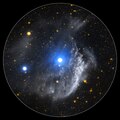Fil:Extended Region Around the Planetary Nebula NGC 3242.tif
Utseende

Storleken för denna JPG-förhandsvisning av denna TIF-fil: 600 × 600 pixlar. Andra upplösningar: 240 × 240 pixlar | 480 × 480 pixlar | 768 × 768 pixlar | 1 024 × 1 024 pixlar | 2 240 × 2 240 pixlar.
Originalfil (2 240 × 2 240 pixlar, filstorlek: 7,34 Mbyte, MIME-typ: image/tiff)
Filhistorik
Klicka på ett datum/klockslag för att se filen som den såg ut då.
| Datum/Tid | Miniatyrbild | Dimensioner | Användare | Kommentar | |
|---|---|---|---|---|---|
| nuvarande | 30 oktober 2013 kl. 23.08 |  | 2 240 × 2 240 (7,34 Mbyte) | Stas1995 | User created page with UploadWizard |
Filanvändning
Följande sida använder den här filen:
Global filanvändning
Följande andra wikier använder denna fil:
- Användande på af.wikipedia.org
- Användande på ar.wikipedia.org
- Användande på cs.wikipedia.org
- Användande på de.wikipedia.org
- Användande på el.wikipedia.org
- Användande på en.wikipedia.org
- Användande på fr.wikipedia.org
- Användande på lb.wikipedia.org
- Användande på vi.wikipedia.org
- Användande på zh.wikipedia.org


